Interleaved Buck Converter for Inductive Wireless Power Transfer in DC–DC Converters
Abstract
1. Introduction
2. Principle of Operation of Proposed Converter
2.1. Circuit Description
2.2. Principle of Operation
- Mode I for the interval 0 < t < 0.5 THB. Figure 3 shows the equivalent circuit when MB1 and MH1 are in the on state. The current flows through the resonant load obtaining the positive half cycle of the expected sinusoidal signal. The peak amplitude is determined by the buck converter output voltage VBuck, which is controlled through D of the PWM burst signal. In the rectifier, the diodes Da and Dd are in the on state during the positive half cycle of the voltage vrx.
- 2.
- Mode II for the interval 0.5 THB < t < 1 THB. Figure 4 shows the equivalent circuit when MB2 and MH2 are in the on state. The current through the resonant circuit flows in the opposite direction of Mode I to generate the negative half cycle of the sinusoidal signal. The output signal peak amplitude is determined by the voltage VBuck, which is controlled through D of the PWM burst signal. In the rectifier, diodes Db and Dc are in the on state during the negative half cycle of the voltage vrx.
3. Simulation Results
4. Experimental Results
5. Comparison of the Proposed Converter with Other DC–DC Topologies
6. Conclusions
Author Contributions
Funding
Acknowledgments
Conflicts of Interest
Nomenclature
| D | Duty cycle |
| MB1 | MOSFET in Buck 1 |
| MB2 | MOSFET in Buck 2 |
| LB1 | Inductor in Buck 1 |
| LB2 | Inductor in Buck 2 |
| DB1 | Diode in Buck 1 |
| DB2 | Diode in Buck 2 |
| MH1, MH2 | MOSFE’s in leg inverter |
| Ctx | Capacitor in parallel resonant circuit in transmitter circuit |
| Ltx | Transmitter inductor |
| Crx | Capacitor in parallel resonant circuit in receptor circuit |
| Lrx | Receptor inductor |
| Cf | Output filter capacitor |
| Da, Db, Dc, Dd | Bridge rectifier diodes |
| VG1, VG3 | Control signals in half bridge rectifier |
| V21, VG4 | Control signals in Buck converters |
| THB | Half bridge inverter control signals |
| VBuck | Buck converter output voltage |
| Vtxpk | Transmitter peak output voltage |
| Vin | Input voltage |
| Vinmax | Maximum input voltage |
| Vtx | Transmitter output voltage |
| Vrx | Receptor input voltage |
| VF | The threshold voltage |
| Ro | Output load |
| RLmin | Minimal load |
| rDS | Mosfet On-resistance |
| rC | Parasitic resistance of capacitor |
| rL | Parasitic resistance of inductor |
| rdiode | Parasitic resistance of diode |
| Vo | Output voltage |
| Io | Output current |
| x1, x2, x3, x4 | State variables |
| IF(AV) | Average forward current |
| iLB1 | Current in LB1 |
| iLB2 | Current in LB2 |
| iLtx | Current in Ltx |
| iLrx | Current in Lrx |
| ΔVo | Output ripple voltage |
| ΔIo | Output ripple current |
| fs | Switching frequency |
| fBurst | Burst signals switching frequency |
| fHB | Half bridge inverter switching frequency |
| Po | Output power |
| Pomax | Maximum output power |
| Pconduction | Conduction power losses |
| Pswitching | Switching power losses |
| PrC | Capacitor power losses |
| Ptotal | Total power losses |
| trr | Reverse recovery time |
| k | Coupling factor in inductors Ltx and Lrx |
| η | Efficiency in the converter |
References
- Galizzi, M.; Caldara, M.; Re, V.; Vitali, A. A novel Qi-standard compliant full-bridge wireless power charger for low power devices. In Proceedings of the IEEE Wireless Power Transfer, Perugia, Italy, 15–16 May 2013. [Google Scholar]
- Yanjun, L.; Yuzhe, C.; Chung, S.C.; Zhibo, W.; Yi-hua, Z. Charging While Moving: Deploying Wireless Chargers for Powering Wearable Devices. IEEE Trans. Veh. Technol 2018, 67, 11575–11586. [Google Scholar]
- Jiejian, D.; Daniel, C.L. A Survey of Wireless Power Transfer and a Critical Comparison of Inductive and Capacitive Coupling for Small Gap Applications. IEEE Trans. Power Electron. 2015, 30, 6017–6029. [Google Scholar]
- Mostafa, T.M.; Muharam, A.; Hattori, R. Wireless battery charging system for drones via capacitive power transfer. In Proceedings of the IEEE Workshop on Emerging Technologies: Wireless Power Transfer, Chongqing, China, 20–22 May 2017. [Google Scholar]
- Zhang, H.; Chong, Z.; Fei, L. Long-Distance and High-Power Capacitive Power Transfer based on the Double-Sided LC Compensation: Analysis and Design. In Proceedings of the IEEE Transportation Electrification Conference and Expo, Detroit, MI, USA, 19–21 June 2019. [Google Scholar]
- Van-Binh, V.; Duc-Hung, T.; Woojin, C. Implementation of the Constant Current and Constant Voltage Charge of Inductive Power Transfer Systems With the Double-Sided LCC Compensation Topology for Electric Vehicle Battery Charge Applications. IEEE Trans. Power Electron. 2018, 33, 7398–7410. [Google Scholar]
- Mohammadhossein, A.; Akshay, K.R. Receiver side control for efficient inductive power transfer for vehicle recharging. In Proceedings of the IEEE Transportation Electrification Conference, Pune, India, 13–15 December 2017. [Google Scholar]
- Chih-Cheng, H.; Chun-Liang, L. Wireless Power and Bidirectional Data Transfer Scheme for Battery Charger. IEEE Trans. Power Electron. 2018, 33, 4679–4689. [Google Scholar]
- Minfan, F.; Chengbin, M.; Xinen, Z. A Cascaded Boost–Buck Converter for High-Efficiency Wireless Power Transfer Systems. IEEE Trans. Ind. Informat. 2014, 10, 1972–1980. [Google Scholar]
- Erdem, A.; Kerim, C.; Dariusz, C. Analysis of cascaded multi-output-port converter for wireless plug-in Hybrid/On-Board EV chargers. In Proceedings of the IEEE Applied Power Electronics Conference and Exposition, Long Beach, CA, USA, 20–24 March 2016. [Google Scholar]
- Xinhong, F.; Ming, L.; Zefan, T.; Chengbin, M. Design procedure of a class E2 DC-DC converter for megahertz wireless power transfer based on a compact class E current-driven rectifier. In Proceedings of the IEEE International Symposium on Industrial Electronics, Edinburgh, UK, 19–21 June 2017. [Google Scholar]
- Tomoharu, N.; Xiuqin, W.; Elisenda, B.; Alarcón, E.; Kazimierczuk, M.K.; Sekiya, H. Analysis and Design of Loosely Inductive Coupled Wireless Power Transfer System Based on Class-E2 DC-DC Converter for Efficiency Enhancement. IEEE Trans. Circuits Syst. I Reg. Pap. 2015, 62, 2781–2791. [Google Scholar]
- Xuejian, G.; Yue, S.; Chunsen, T.; Zhihui, W.; Zhou, X. Loss analysis and efficiency optimization of buck converter in wireless charging system for EVs. In Proceedings of the IEEE Workshop on Emerging Technologies: Wireless Power Transfer, Chongqing, China, 20–22 May 2017. [Google Scholar]
- Carbajal-Retana, M.; Camacho-Cabrera, J.; Hernandez-González, L.; Tapia-Hernández, A. Buck-inverter converter for application in inductive wireless transmission. In Proceedings of the IEEE International Conference on Power Electronics, Cholula Puebla, Mexico, 24–26 October 2018. [Google Scholar]
- Yungtaek, J.; Jovanovic, M.M. A contactless electrical energy transmission system for portable-telephone battery chargers. IEEE Trans. Ind. Electron. 2003, 50, 520–527. [Google Scholar] [CrossRef]
- Jun-Young, L.; Byung-Moon, H. A Bidirectional Wireless Power Transfer EV Charger Using Self-Resonant PWM. IEEE Trans. Power Electron. 2015, 1784–1787. [Google Scholar]
- Liu, C.; Hu, A.P.; Nair, K.C. Modelling and analysis of a capacitively coupled contactless power transfer system. IET Power Electron. 2011, 808–815. [Google Scholar] [CrossRef]
- Theodoridis, M.P. Effective Capacitive Power Transfer. IEEE Trans. Power Electron. 2012, 4906–4913. [Google Scholar] [CrossRef]

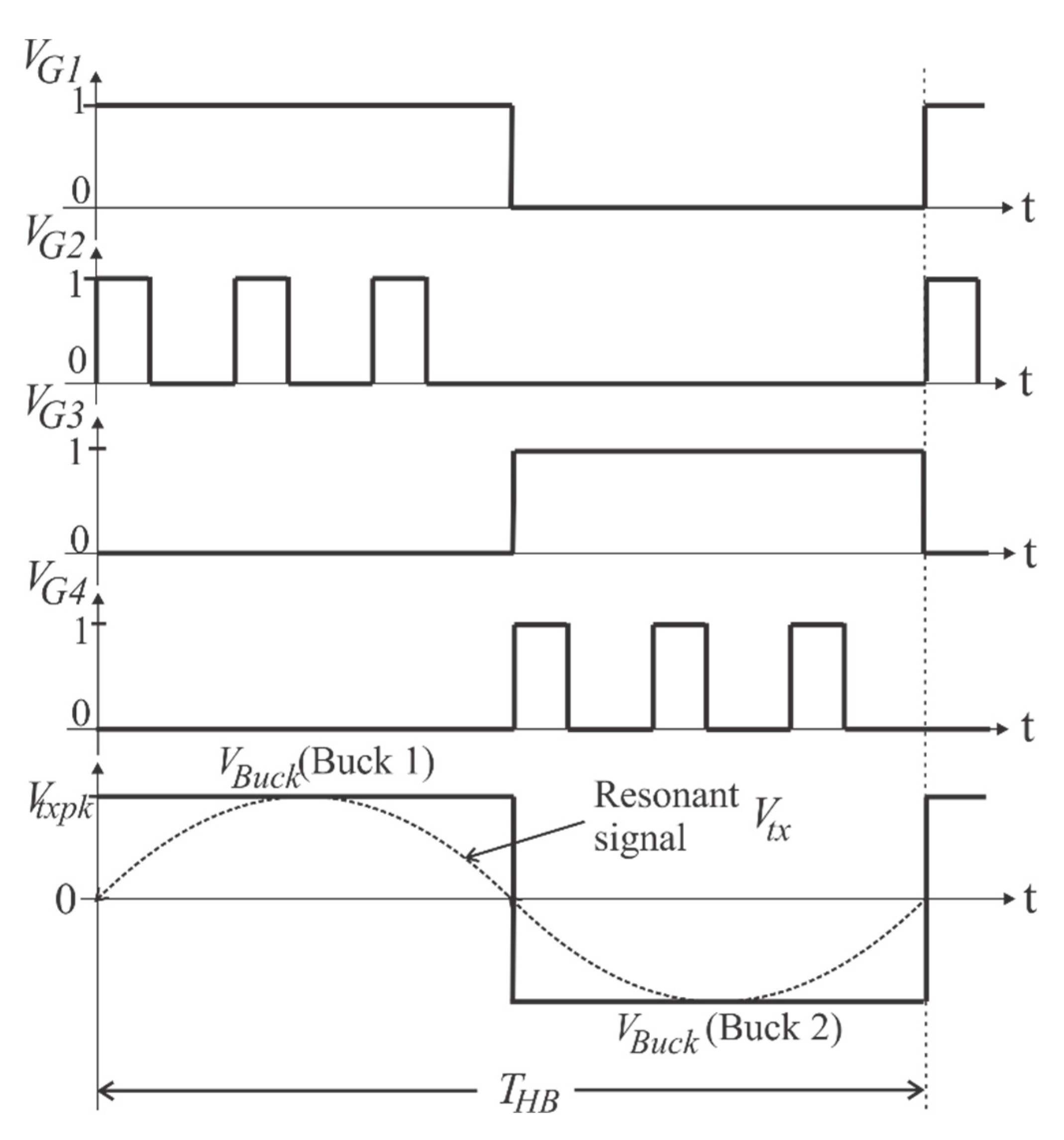

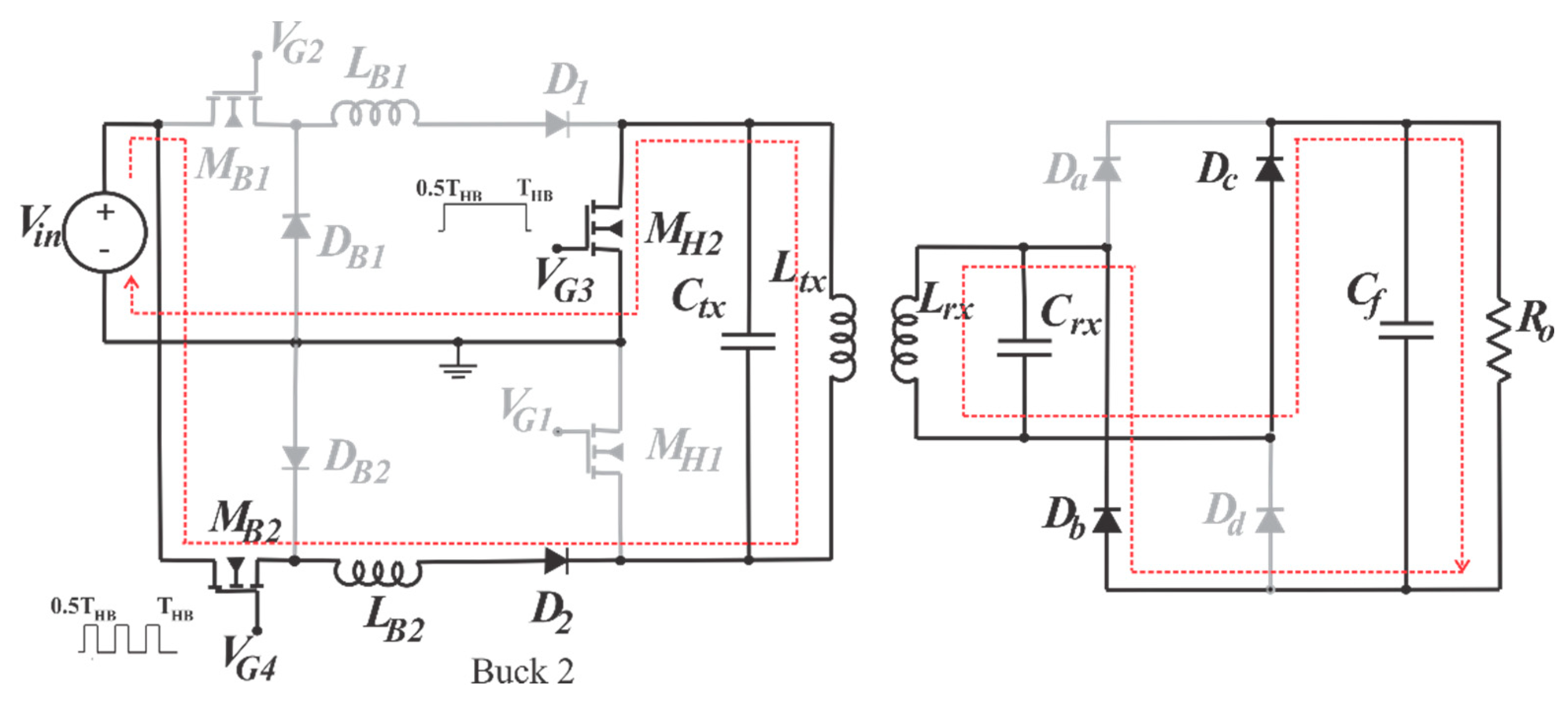


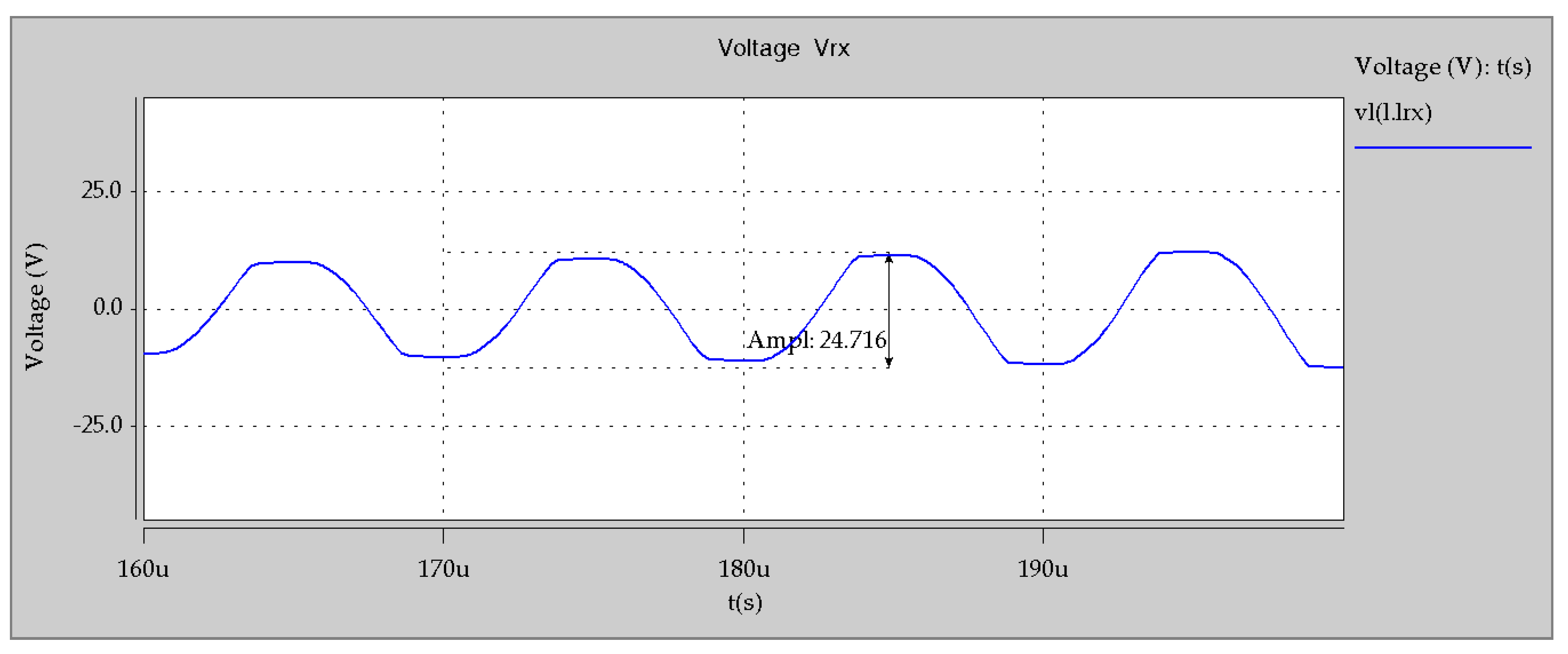
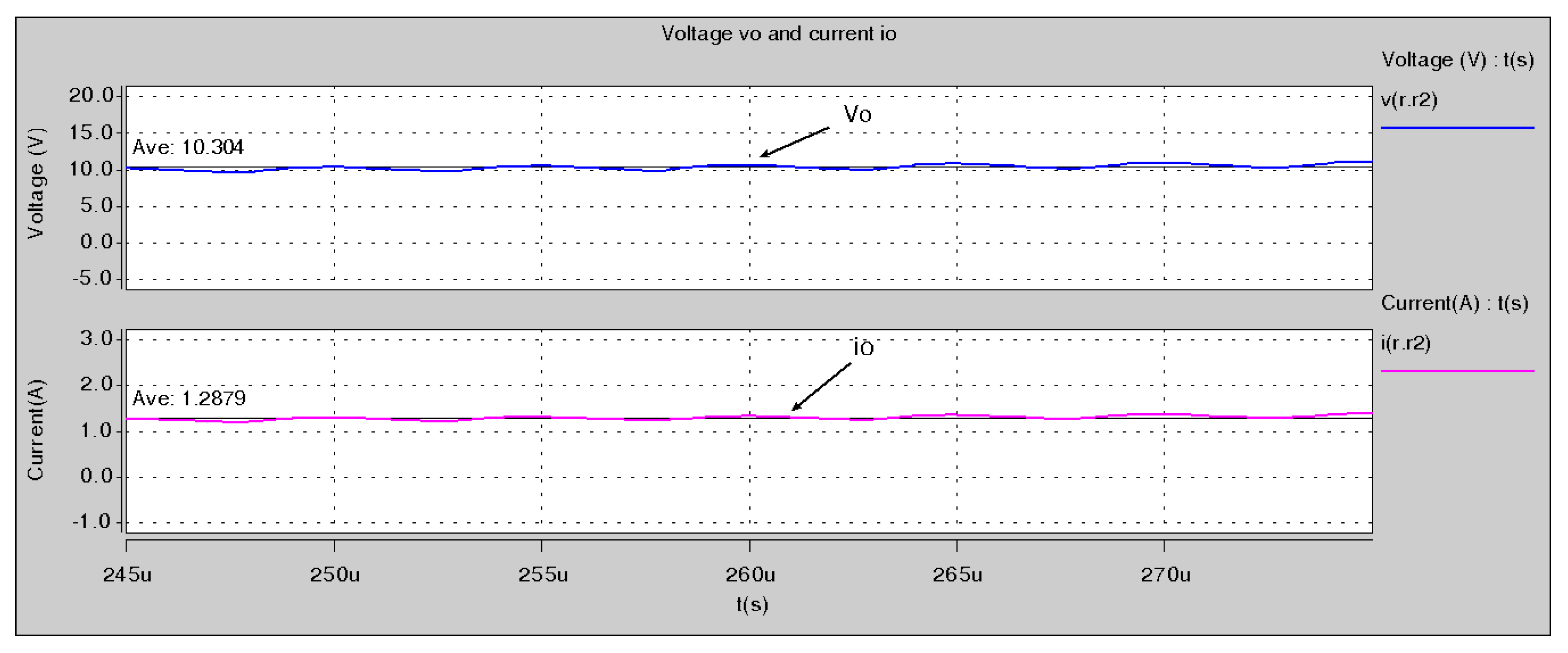
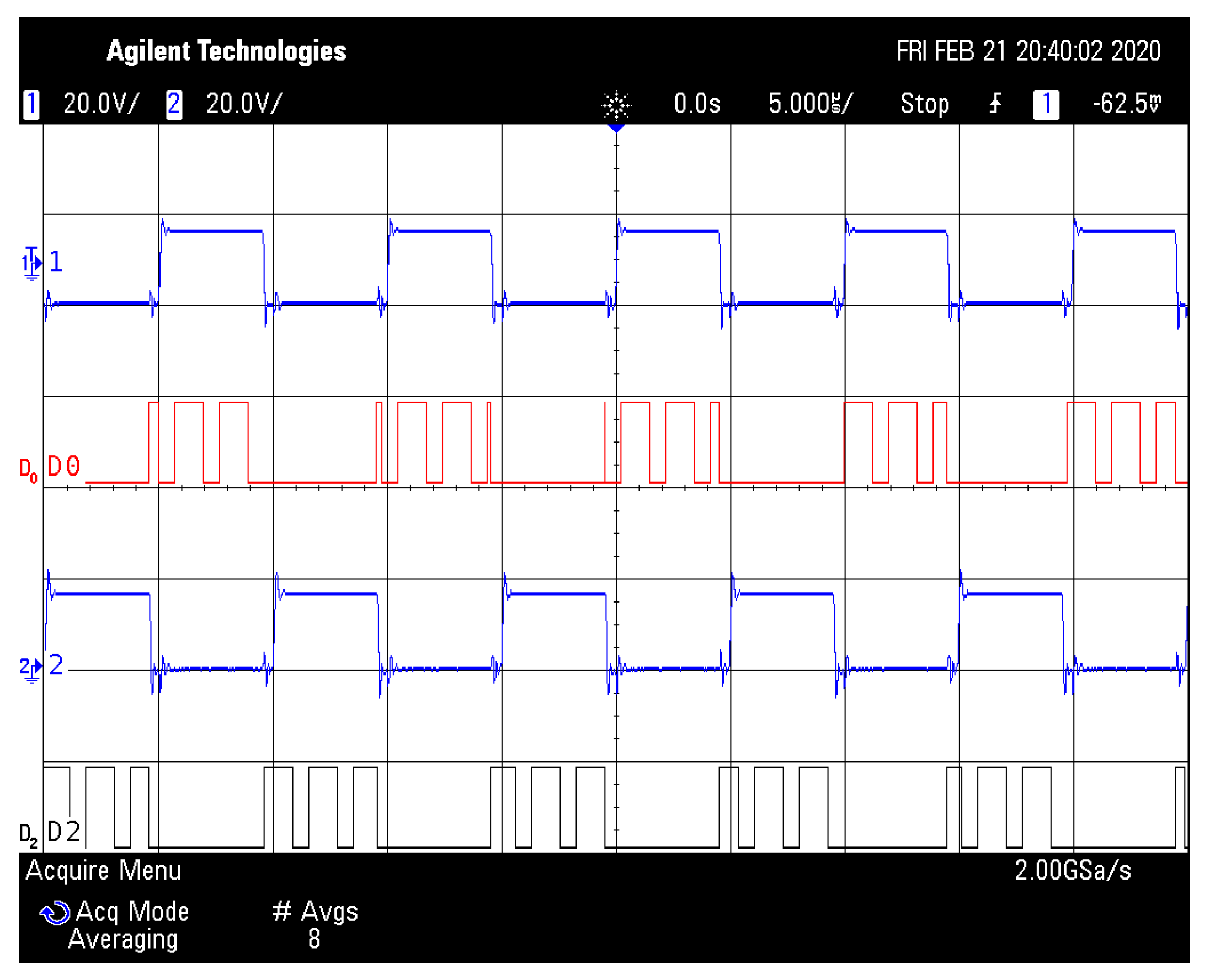

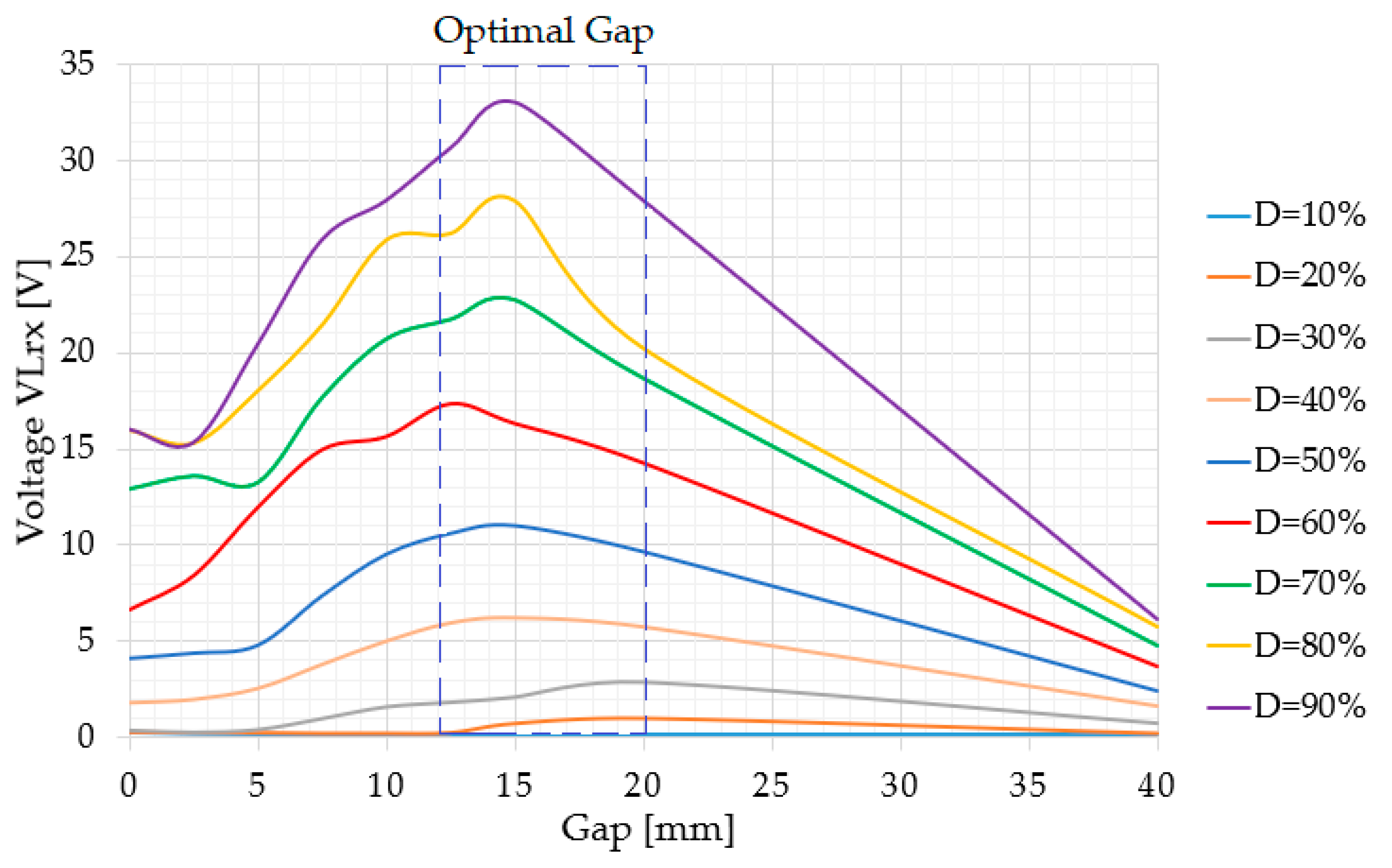

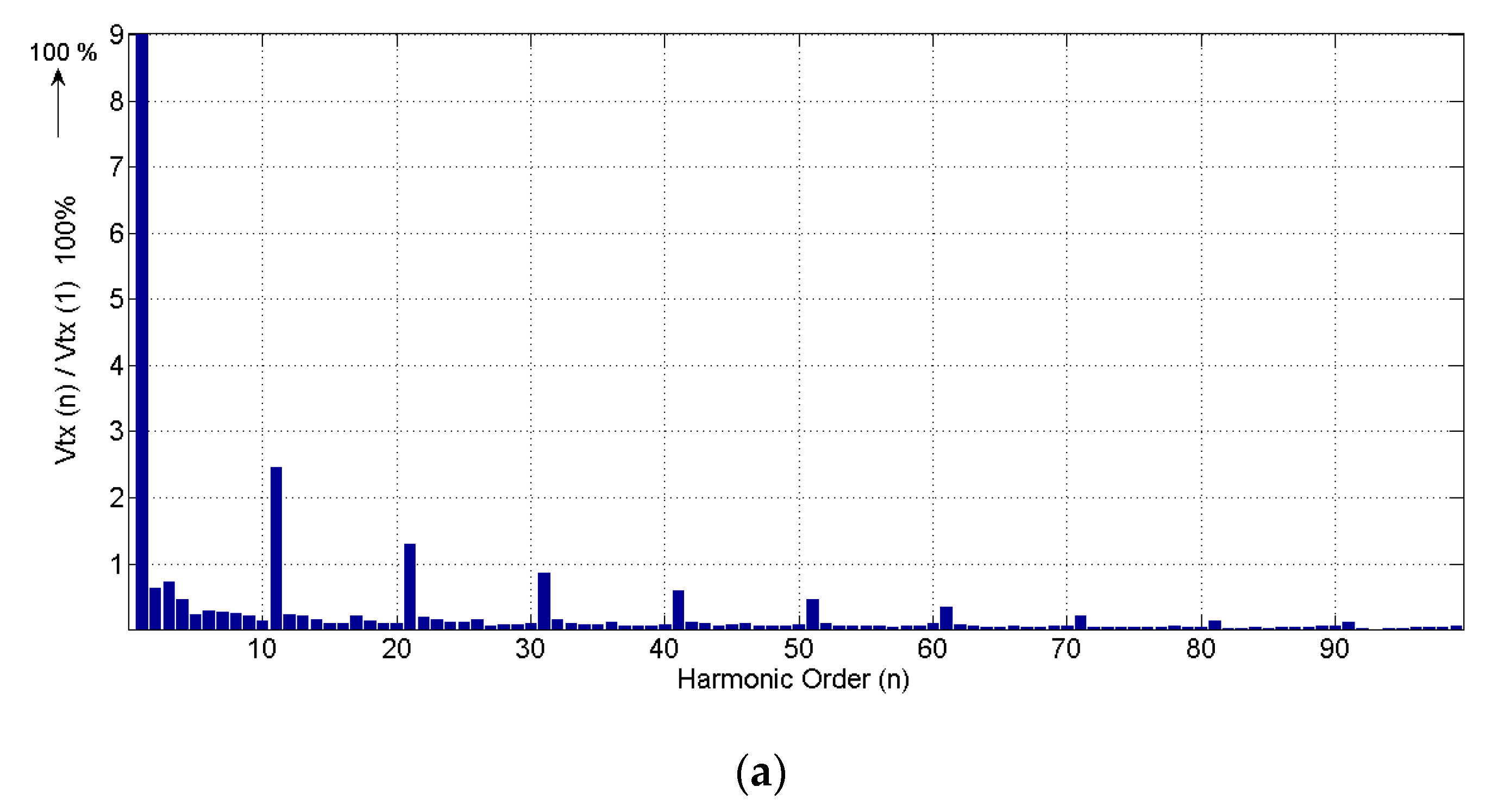
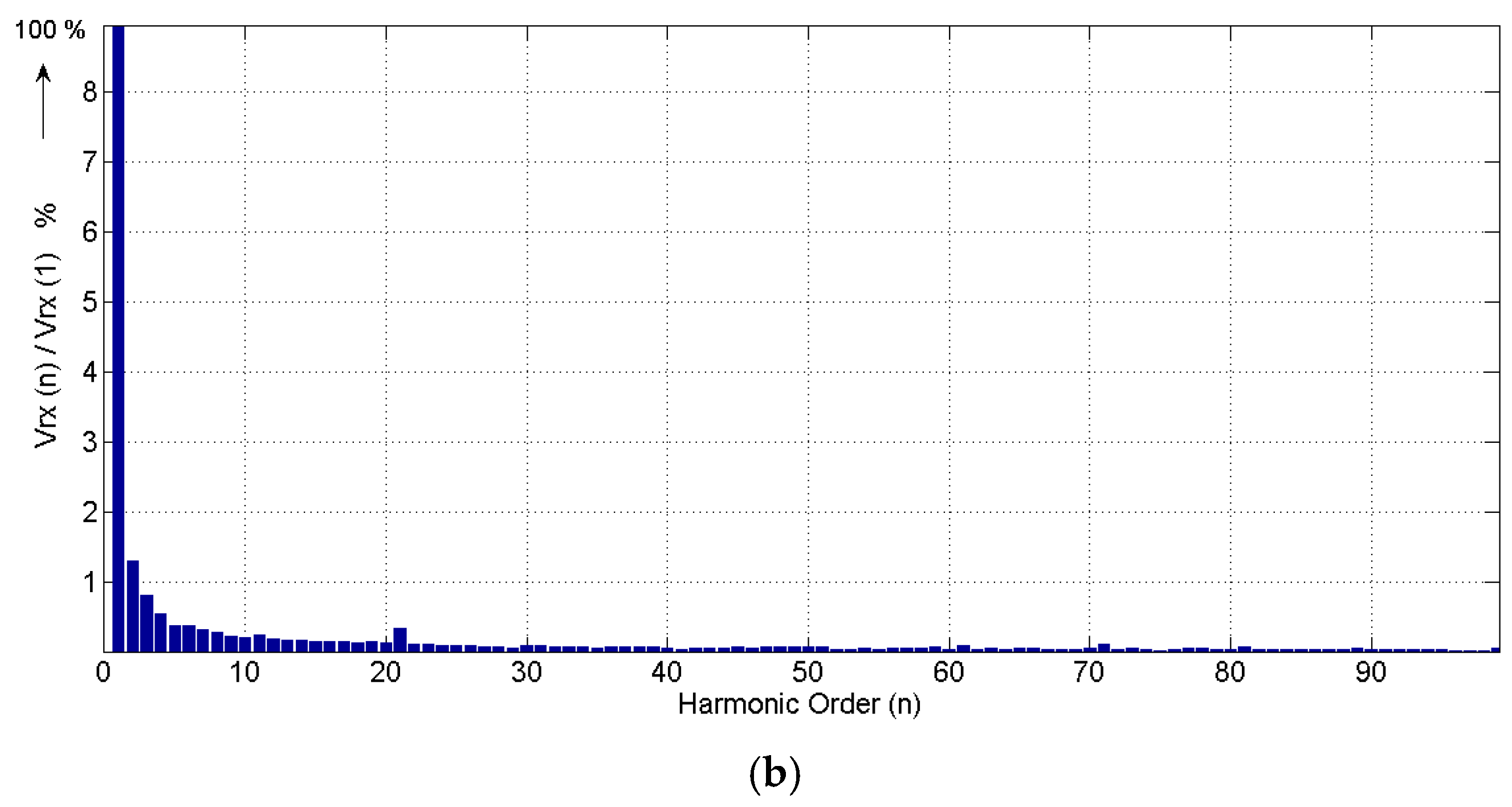


| Quantity | Value |
|---|---|
| Supply voltage Vin | 25 V |
| Output voltage V0 | 10 V |
| Output power Po | 15 W |
| Ripple voltage ΔVo | 10% of Vo |
| Switching frequency of burst PWM signal fBurst | 500 kHz |
| Switching frequency of inverter leg fHB | 100 kHz |
| Inductors LB1 and LB2 | 130 µH |
| Capacitor Ctx | 0.47 µF |
| Capacitor Crx | 220 nF |
| Capacitor Cf | 4.7 µF |
| Inductor Ltx | 6.3 µH |
| Inductor Lrx | 12 µH |
| Output load Ro | 330 Ω |
| Quantity | Value |
|---|---|
| Source voltage Vin | 25.0 V |
| Output voltage Vo | 10.0 V |
| Switching frequency of burst PWM signal fBurst | 500 kHz |
| Switching frequency of inverter leg fHB | 100 kHz |
| Inductors LB1 and LB2 | 130 µH |
| Capacitor Ctx | 0.47 µF |
| Capacitor Crx | 220 nF |
| Capacitor Cf | 4.7 µF |
| Inductor Ltx | 6.3 µH |
| Inductor Lrx | 12.0 µH |
| Output load Ro | 330 Ω |
| Device | Type |
|---|---|
| MOSFETs | CMF10120D |
| Diodes, DB1 and DB2 | C2D10120 |
| Diodes Da, Db, Dc and Dd | 1N5822 |
| Topology | Proposed DC–DC Converter | Cascaded Buck-Boost Converter [9] | Contactless Electrical Energy Transmission System [15] | Bidirectional WPT EV Charger Using Self-Resonant PWM [16] | Capacitively Coupled Contactless Power Transfer System [17] | Capacitive Power Transfer [18] | |
|---|---|---|---|---|---|---|---|
| Factor | |||||||
| Semiconductor devices transmitter-receptor | 4 | 4(only in receptor) | 2 | 4 | 2–4 | 2–4 | |
| Energy storage components | 3 | 2 | 3 | 3 | 8 | 6 | |
| Switching frequency | 500 kHz | 20 kHz | 67–140 kHz | 20.3 kHz | 840 kHz | 1 MHz | |
| Efficiency η | 85.1% | 74% | 60–70% | 88% | 41% | 80% | |
| Output Power | 15 W | 40 W | 4.5 W | 6.6 kW | 7.6 W | 25 W | |
| Advantages | The proposed topology and control method are simple and achieve high efficiency | This topology provides an optimal impedance for minimal power reflection | This topology allows bidirectional power flow through the inductances | The high power makes it suitable for electric vehicle applications | Zero Voltage Switching (ZVS) is used to reduce losses | The design algorithm ensures reduction of the system size | |
| Major Drawbacks | Work in progress to achieve higher output power | Electromagnetic components could be reduced by increasing the switching frequency | The distortion in voltage waveforms avoids a higher efficiency in the system | Electromagnetic components could be reduced by increasing the switching frequency | The power efficiency is too low under heavy load conditions | Some losses may be compensated by using a ZVS | |
© 2020 by the authors. Licensee MDPI, Basel, Switzerland. This article is an open access article distributed under the terms and conditions of the Creative Commons Attribution (CC BY) license (http://creativecommons.org/licenses/by/4.0/).
Share and Cite
Carbajal-Retana, M.; Hernandez-Gonzalez, L.; Ramirez-Hernandez, J.; Avalos-Ochoa, J.G.; Guevara-Lopez, P.; Loboda, I.; Sotres-Jara, L.A. Interleaved Buck Converter for Inductive Wireless Power Transfer in DC–DC Converters. Electronics 2020, 9, 949. https://doi.org/10.3390/electronics9060949
Carbajal-Retana M, Hernandez-Gonzalez L, Ramirez-Hernandez J, Avalos-Ochoa JG, Guevara-Lopez P, Loboda I, Sotres-Jara LA. Interleaved Buck Converter for Inductive Wireless Power Transfer in DC–DC Converters. Electronics. 2020; 9(6):949. https://doi.org/10.3390/electronics9060949
Chicago/Turabian StyleCarbajal-Retana, Marco, Leobardo Hernandez-Gonzalez, Jazmin Ramirez-Hernandez, Juan Gerardo Avalos-Ochoa, Pedro Guevara-Lopez, Igor Loboda, and Luis Antonio Sotres-Jara. 2020. "Interleaved Buck Converter for Inductive Wireless Power Transfer in DC–DC Converters" Electronics 9, no. 6: 949. https://doi.org/10.3390/electronics9060949
APA StyleCarbajal-Retana, M., Hernandez-Gonzalez, L., Ramirez-Hernandez, J., Avalos-Ochoa, J. G., Guevara-Lopez, P., Loboda, I., & Sotres-Jara, L. A. (2020). Interleaved Buck Converter for Inductive Wireless Power Transfer in DC–DC Converters. Electronics, 9(6), 949. https://doi.org/10.3390/electronics9060949





